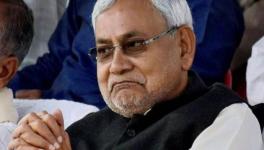Nitish Kumar’s Patna or a Graveyard of History?
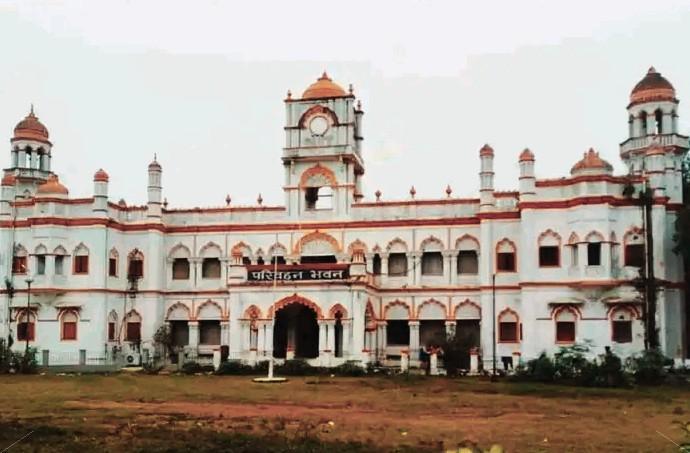
Sultan Palace
The coalition government of Bharatiya Janata Party and Janata Dal-United, under the leadership of Nitish Kumar, has passed a resolution for the construction of a luxurious private hotel at the same place where exists the ‘Transport Bhawan’. This decision could have just been an example of the increased state-sponsored privatisation in and outside Bihar if the ‘Transport Bhawan’ was not the iconic Sultan Palace with a legacy of more than 100 years.
Constructed within a time period of three years and completed in 1922, Sultan Palace was the beloved abode of Barrister Sir Sultan Ahmed KCSI (Knight Commander of the Order of the Star of India) - the very first Indian Vice-Chancellor of the Patna University. Sir Sultan Ahmad was a staunch voice of opposition to the idea of India's partition and even declined Mohammad Ali Jinnah's offer to be a cabinet minister in Pakistan.
The decision to demolish this iconic piece of heritage is quite similar to another attempt made last year. The same Bihar government was hellbent on bulldozing a part of the historic Khuda Bakhsh Oriental Public Library in order to construct a flyover. The decision was withdrawn as several civil society organisations and political parties protested this impudent behaviour of the Nitish Kumar government. A similar situation can be seen in the case of Sultan Palace, where multiple journalists, archivists and activists have already started organising and are explicitly vocal about saving this quintessential Indo-Islamic architectural heritage.
At a time when it feels good to see a lot of people who care to preserve these capsules to the past, the heart aches for the buildings and monuments that the same government destroyed in the past decade.
GULZARBAGH ESTATE
Founded in the early 1700s, the Gulzarbagh estate was registered as a Waqf property after the death of Nawab Saadat Ali Khan 'Tamkeen' of Doolighat by his wife Imam Bandi Begum in the year 1890. The estate constituted a mosque, an Imambara, the residential area and the raiyat khana (inhabited mostly by the poor people paying a nominal rent). Amid the COVID-19 Pandemic, Raiyat Khana and the Deohri of the Estate were demolished by the Bihar State Shia Waqf Board in order to lease out the land for a private hospital. Later on, when this was challenged in the court, the further constructions were stopped, but the poor inhabitants belonging to the working class were left homeless.
The remaining historical aspects of the estate were fortunate enough to remain untouched as the site serves as an important religious centre for the Shia Muslim community.
SHAHI SANGI MASJID
Built during the reign of the Mughal Emperor Jahangir by his son Parwez Shah in 1621. The Shahi Sangi Masjid, which is commonly known as the Paththar Ki Masjid, is one of the earliest standing Mughal monuments in Patna. In the year 2020, the Bihar government, with the Waqf Board as its aide, executed a plan to construct a big-shot shopping complex in its place.
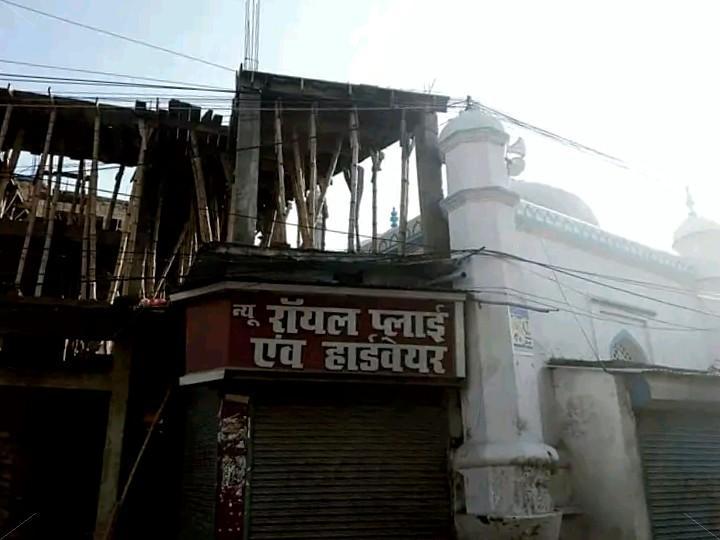
The shopping complex under construction as of June 2020. Credits: Zeeshan Ahmad Khan
The construction of the shopping complex was done in such a manner that the domes of the mosque would have been completely invisible from the main road. Several pillars of the shopping complex even harmed the Mughal structure. This intrusion by the government faced a huge backlash from the residents of the city, already fed up with demolitions carried out earlier. This ultimately led to a halt in the construction along with the downfall of Irshad Ali Azad, the then chairman of the Waqf board.
MOHAMMAD RAZA KHAN WAQF ESTATE
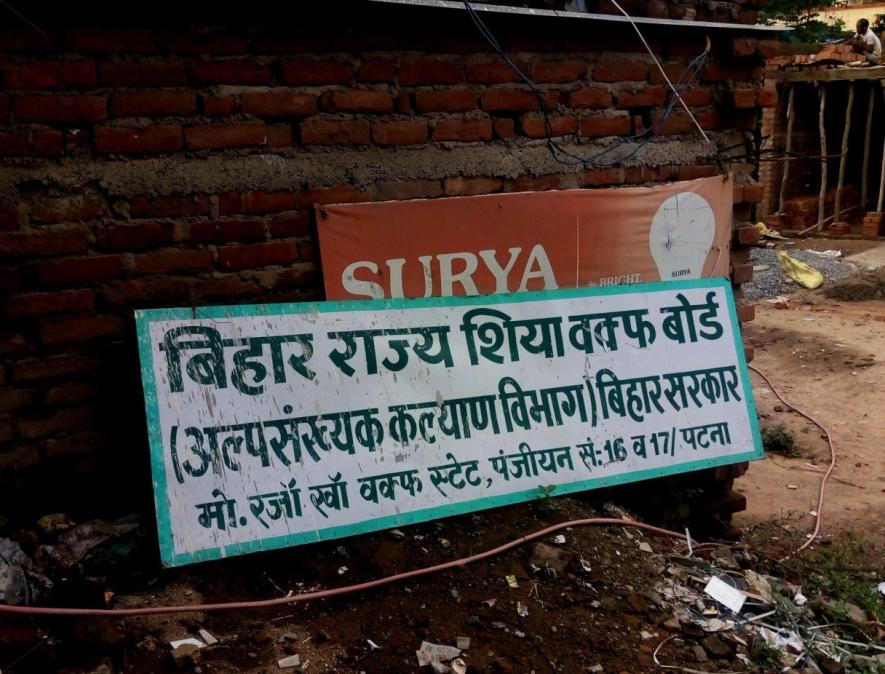
A board with the details of the estate, lying in a corner where once existed a beautiful mansion.
Situated in the Guzri Bazar at the Ashok Rajpath, Nawab Mohammad Raza Khan Bahadur 'Farhad' of Doolighat registered his property as Waqf back in the year 1897. Being an important poet of his time, 'Farhad' traces his poetic traditions back to the legends of Urdu Literature, Mirza Dabeer and Mirza Ghalib. A trained doctor, painter and poet known for his socialist ideas, Mohammad Raza Khan, around a kilometre away from his ancestral palace at Doolighat, created a paradise for himself and his child Qasim - who died young, as a teenager.
His estate included his Kothi, library, a mosque and an Imambara constructed in the 1870s along with 22 shops rented by the poor at nominal rates.. His estate indeed served as a paradise for the working class of this city.
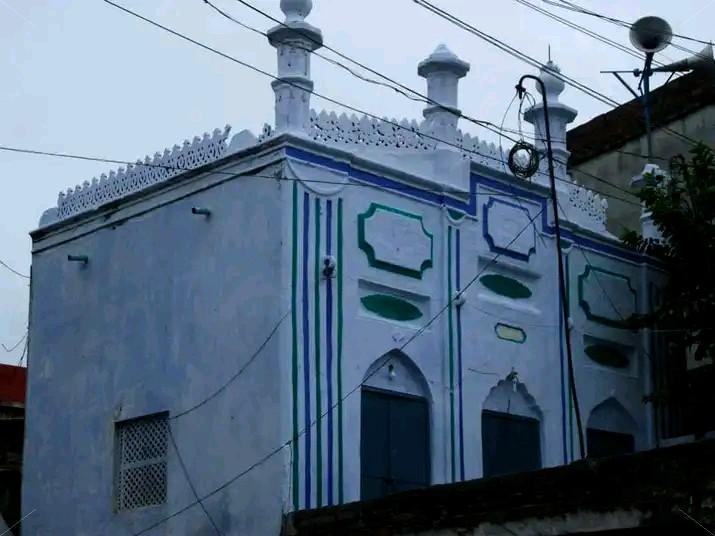
The Mosque built by Nawab Mohammad Raza Khan, before it was demolished by the Bihar State Shia Waqf Board
The Waqf Board snatched this from the hands of its caretakers (the family of Nawab Safdar Hussain Khan), who were against its demolition and razed it to the ground. His mosque, which was a fine example of the later-Mughal architecture in Bihar, was shattered into pieces under a cruel hoax of development.
For three years, this place lies as barren land; the shop owners got stripped of their established businesses under the orders of the Bihar Government.
SANGIDALAAN
Built in 1722 AD by Nawab Ahmad Ali Khan 'Qayamat', Sangidalaan - (a monument of marbles) constitutes an Imambara along with a graveyard registered as a Waqf property at Khwajakalan, Patna City, with the graves of important Sufi Mystics and poets including Nawab Ahmad Ali Khan 'Qayamat', Nawab Khadim Hussain Khan 'Khadim', the Sufi poet Hedayat Hussain Khan 'Momin' – a disciple of Shah Kamaal Ali, Jaffer Hassan Khan 'Faiz' a revolutionary poet from the revolt of 1857 and a lot more.

The grave of Nawab Ahmad Ali Khan ‘Qayamat’, one of the last surviving graves in Sangidalaan
This graveyard has turned into a huge market space eliminating the traces of the graves to a larger extent. The importance of this graveyard in Patna's history is very much visible through a couplet by Shad Azeemabadi;
Nikal aa bolti tasweer ab daalan-e-sangi se
Ke jiske dekhne ke waaste patna mein’ mela hai
(The corpses are the sole memories of the Sangidalaan (a marbled monument),
To witness which there is a festival in Patna) [Translation: Shivangi Pandey]
Sangidalaan, which has now turned into a small concrete structure, is also significant because of being one of the earliest established centres for the commemoration of Muharram in Patna.
ANJUMAN-E-ISLAMIA HALL
Established in the year 1885, under the Bihar State Sunni Waqf Board, the Anjuman e Islamia hall stood at the Ashok Rajpath and was listed as a heritage building holding innumerable tales of the Independence struggle. Last year the building was removed from Patna's landscape under the orders of Irshadullah, the chairman of the Sunni Waqf Board and Nitish Kumar, who wanted to inaugurate the new building even before the Bihar elections in 2020.
PATNA COLLECTORATE
The architectural beauty of the Dutch era is a fine example of the time when Patna was a thriving port city and a trading hub for the Dutch East India Company even before the British arrival. Nitish Kumar, the Chief Minister of Bihar himself, laid down the foundation stone of the new complex ordering the demolition of the building worth 250 years of history. Faced with a number of protests nationally and internationally, the Supreme Court of India in the month of September 2020 ordered a stay upon its demolition.
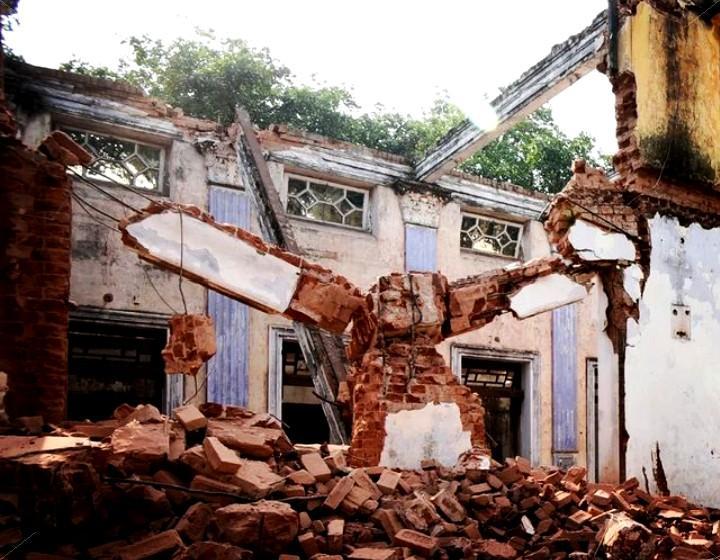
Demolished Patna Collectorate. Credits: @savehistoricpatnacollectorate
However, the apex court of India gave the nod in support of its demolition, and one of the last surviving Dutch structures in Patna was razed to the ground.
If we have a quick recap of all these buildings and monuments which were either completely or partially destroyed in the past three to four years belong to the non-Hindu heritage of the city. Nitish Kumar, walking hand in hand with the Modi-led NDA, has, in fact, turned into a true heir of Uttar Pradesh's 'Bulldozer Baba'.
The decision to demolish this iconic Sultan Palace is just a step forward in ripping Bihar of its multi-cultural heritage. Blindfolded by the Hindutva model of the Bharatiya Janata Party, Nitish Kumar has pushed one of the few last nails in the coffin of Azeemabad’s (Patna’s) History.
Ali Fraz Rezvi is a theatre artist and activist who covers history, heritage and literature.
Get the latest reports & analysis with people's perspective on Protests, movements & deep analytical videos, discussions of the current affairs in your Telegram app. Subscribe to NewsClick's Telegram channel & get Real-Time updates on stories, as they get published on our website.











